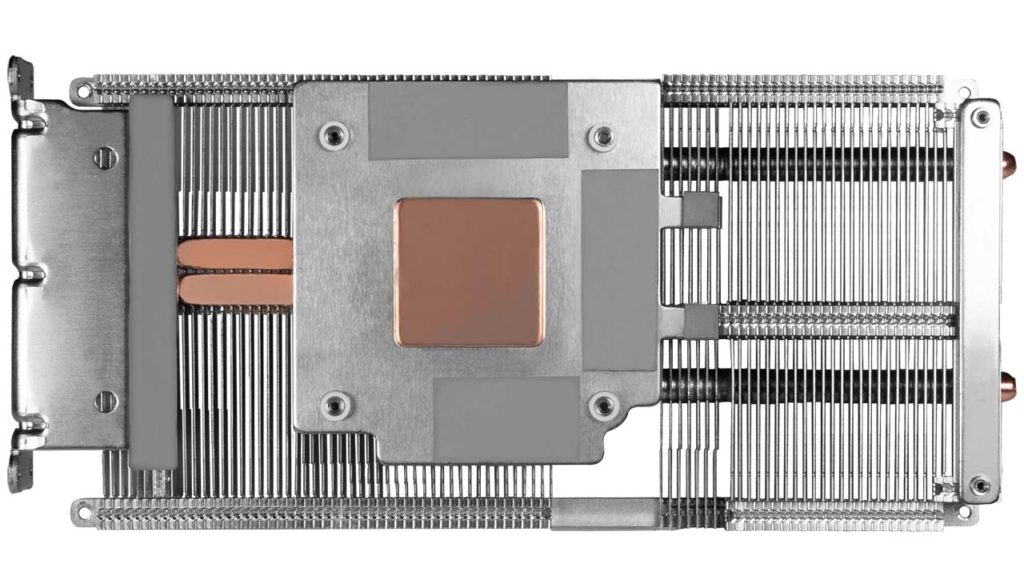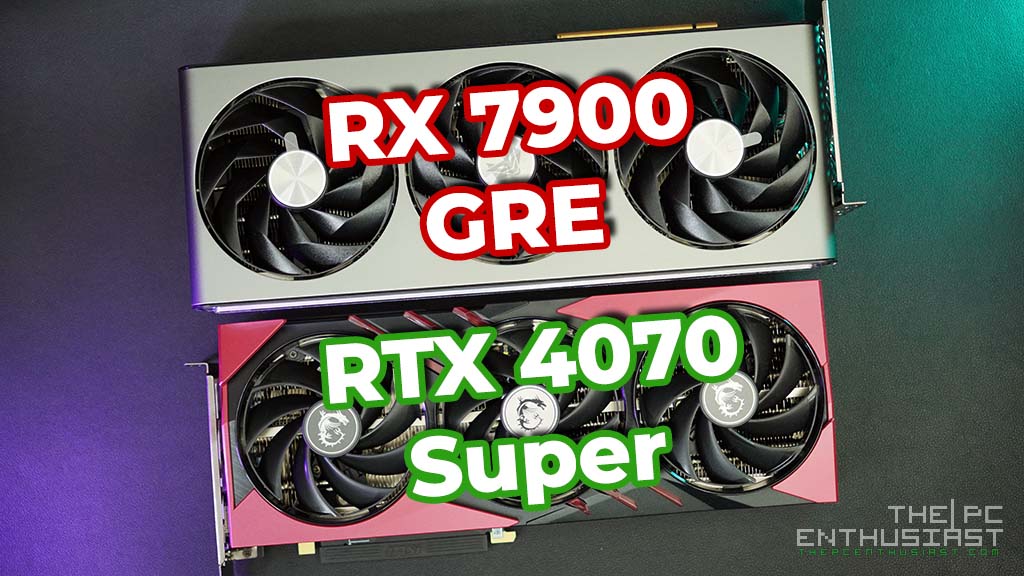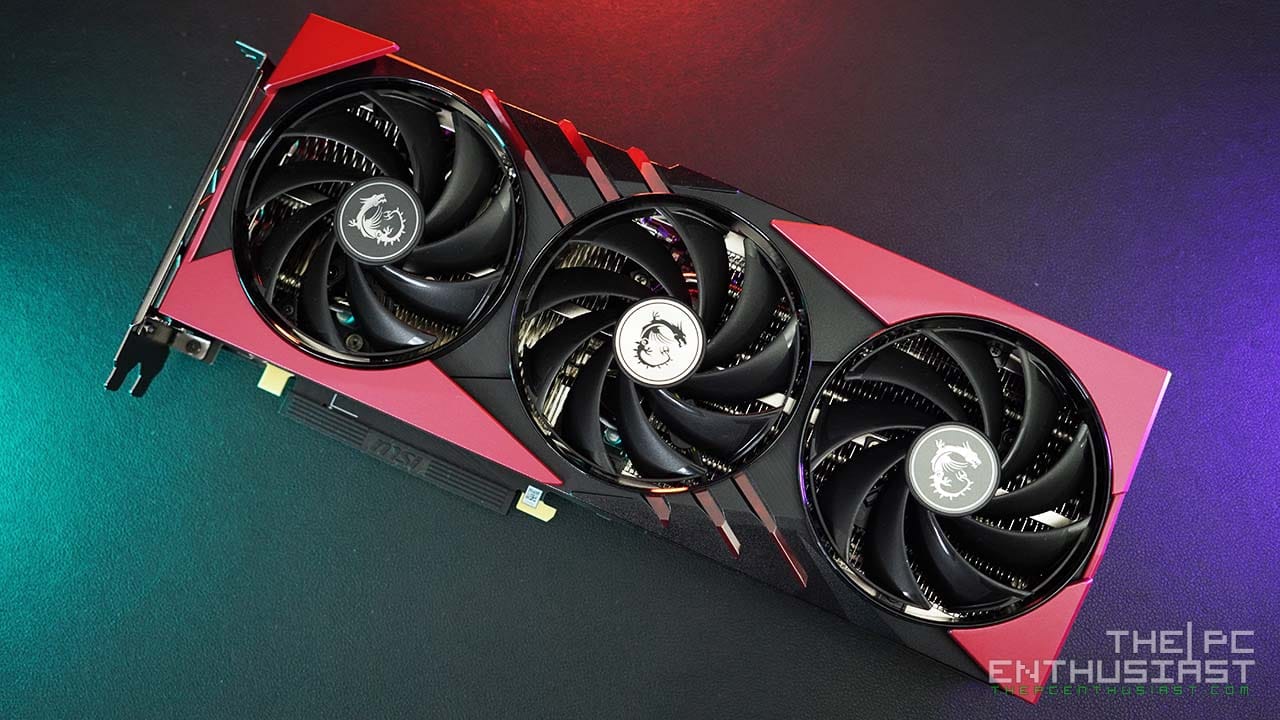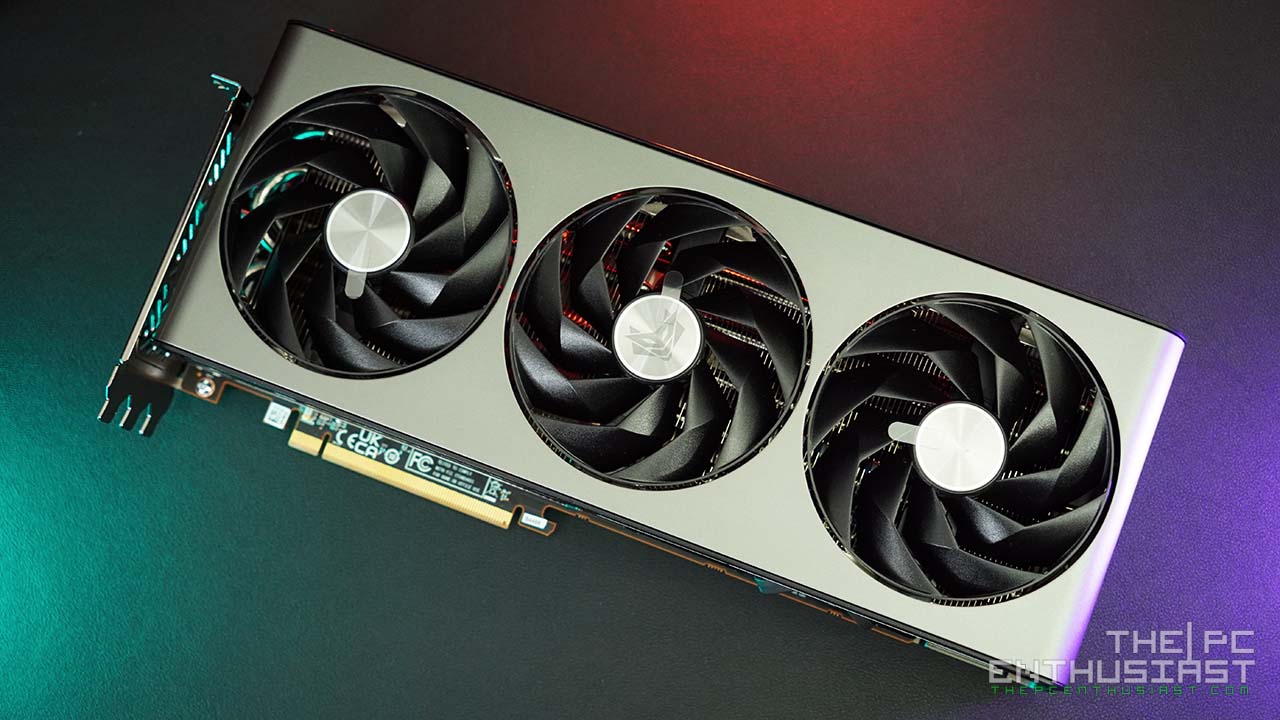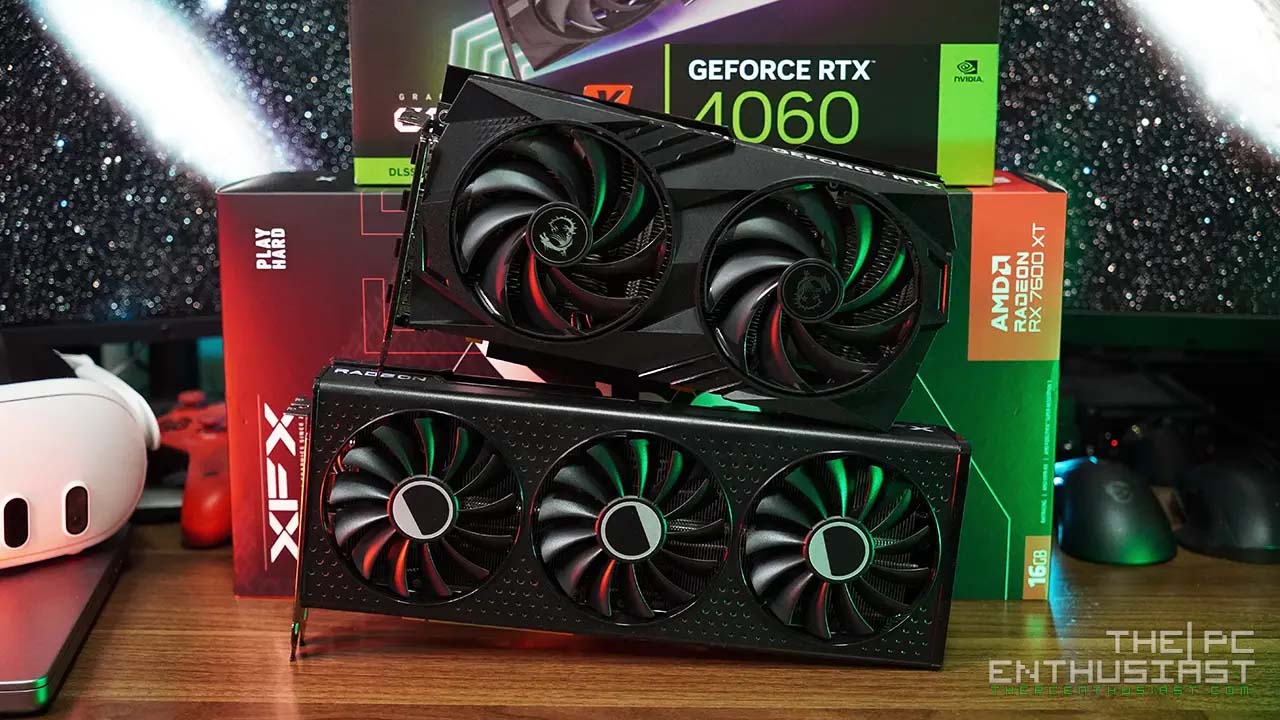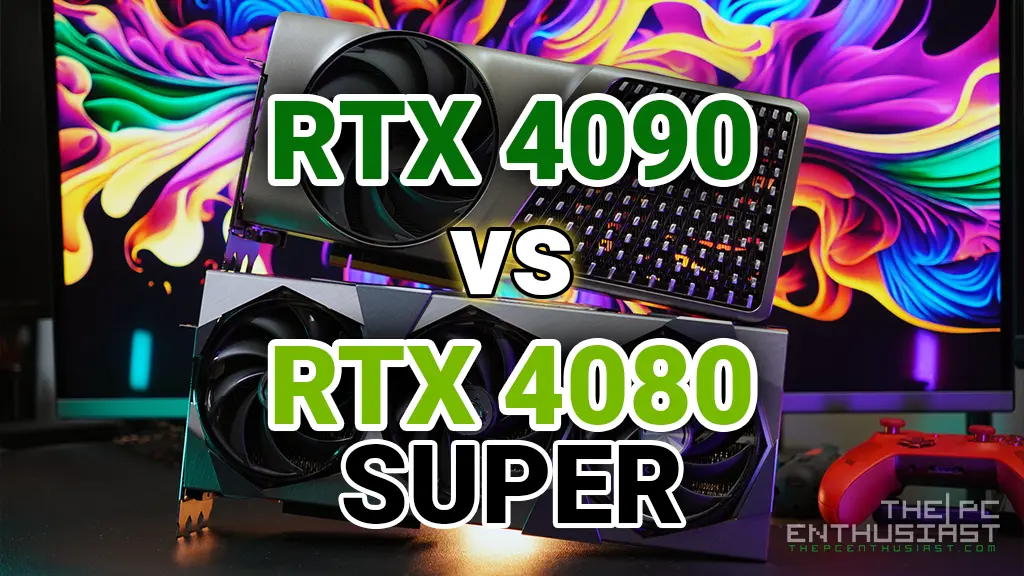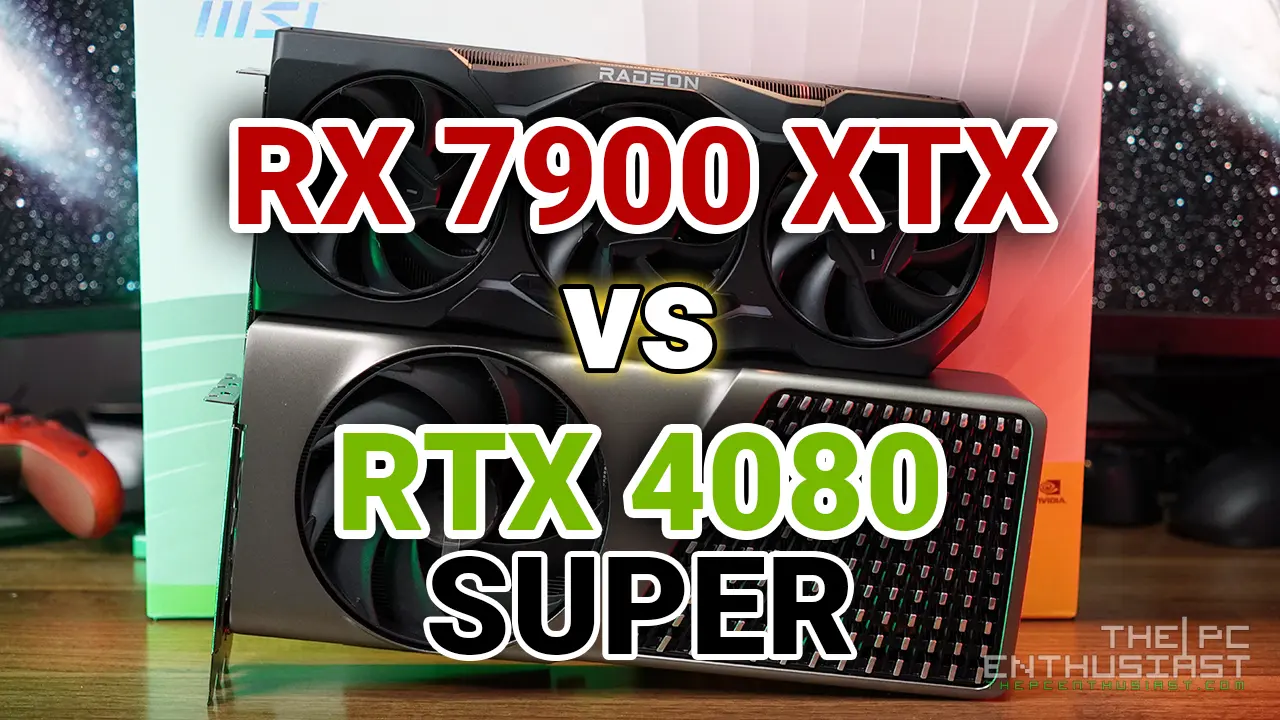Today we are checking out the GALAX GeForce RTX 3050 EX graphics card. GALAX has two models for the RTX 3050 series, and the EX model is the better one compared to the non-EX. The GALAX RTX 3050 EX has a dual-fan cooling solution, RGB lighting, and a slightly higher boost clock speed than the reference model. All of that is in a, somewhat, small form factor. Let’s check out how GALAX’s RTX 3050 EX graphics card performs in our review below.
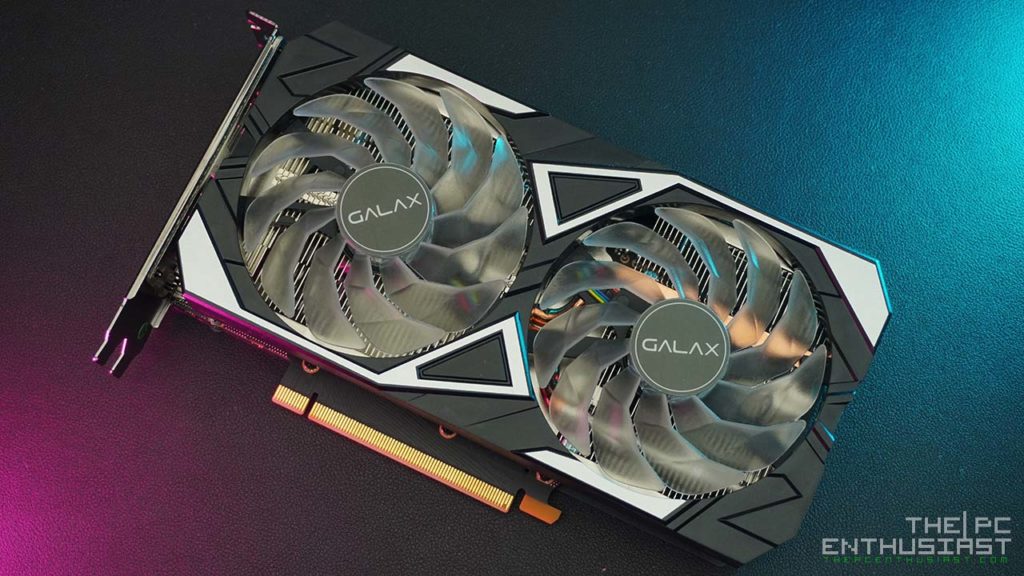
GALAX RTX 3050 Gaming EX Review
NVIDIA brings ray tracing and DLSS features into entry-level GPU. This is like the “RTX 2050” that we never had. Ray tracing is a stretch for this GPU, but DLSS is certainly a useful feature for entry-level GPUs. The RTX 3050 is built with 2nd generation RT cores for ray tracing and 3rd generation Tensor cores for DLSS and AI.
The RTX 3050 has 2,560 CUDA cores, 80 Tensor cores, 20 RT cores, and 32 ROPs. It can deliver 9 shader TFLOPS, plus 18 RT-TFLOPS and 73 Tensor-TFLOPS for ray tracing and performance-boosting AI. The GPU is paired with an 8GB of GDDR6 memory; with a clock speed of 14Gbps; a bandwidth of 224 Gb/s; and runs on a 128-bit memory interface.
NVIDIA didn’t remove any essential Ampere features on the RTX 3050. Gamers/users have access to features like HDMI 2.1 that enables support for 4K@120Hz. It features AV1 decode as well, which provides better compression and quality compared to existing codecs like H.264, HEVC, and VP9. AV1 is said to provide ~50% bitrate savings over H.264. There are also other Ampere-based features like the NVIDIA Reflex Low Latency Technology; and NVIDIA Broadcast.
GALAX RTX 3050 Gaming EX Features
The GALAX’s EX series is the company’s higher-end model of graphics cards. The flagship is the HOF (Hall of Fame) cards, but the HOF is usually reserved for the higher-end of flagship GPUs. Design-wise, the RTX 3050 EX is like a small and compact version of the RTX 3060 EX we reviewed before.
It features two 92mm fans with GALAX’s “Wing” fan blades. There’s also a decent size of aluminum heatsink and a copper base for the GPU. The RTX 3050 GPU doesn’t require a massive heatsink to keep its temperature low. I’ll discuss more of its features as we take a closer look at the graphics card. Meanwhile, below are the rest of the specifications of the RTX 3050.
NVIDIA GeForce RTX 3050 Specifications
| GALAX RTX 3050 EX | RTX 3050 | RTX 3060 | RTX 3060 Ti | |
|---|---|---|---|---|
| Fab Process | 8nm | 8nm | 8nm | 8nm |
| Architecture | Ampere | Ampere | Ampere | Ampere |
| GPU | GA106 | GA106 | GA106 | GA104 |
| CUDA Cores | 2560 | 2560 | 3584 | 4864 |
| Tensor Cores | 80 (3rd gen) | 80 (3rd gen) | 112 (3rd gen) | 152 (3rd gen) |
| RT Cores | 20 (2nd gen) | 20 (2nd gen) | 28 (2nd gen) | 38 (2nd gen) |
| Texture Units | 80 | 80 | 112 | 152 |
| ROPs | 32 | 32 | 48 | 80 |
| Base Clock | 1552 MHz | 1552 MHz | 1320 MHz | 1410 MHz |
| Boost Clock | 1822 MHz | 1777 MHz | 1777 MHz | 1665 MHz |
| Memory Size | 8GB | 8GB | 12GB | 8GB |
| Memory Type | GDDR6 | GDDR6 | GDDR6 | GDDR6 |
| Memory Clock | 14 Gbps | 14 Gbps | 15 Gbps | 14 Gbps |
| Memory Bandwidth | 224 GB/s | 224 GB/s | 360 GB/s | 448 GB/s |
| Memory Interface | 128-bit | 128-bit | 192-bit | 256-bit |
| Power Connectors | 8-pin | 8-pin | 8-pin | 8-pin |
| Graphics Card Power | 130W | 130W | 170W | 200W |
| Recommended PSU | 550W | 550W | 550W | 600W |
| Starting at (MSRP) | ??? | $249 | $329 | $399 |
Packaging and Closer Look
(#ad) Check GeForce RTX 3050 graphics cards’ latest pricing and availability on Amazon.com here.
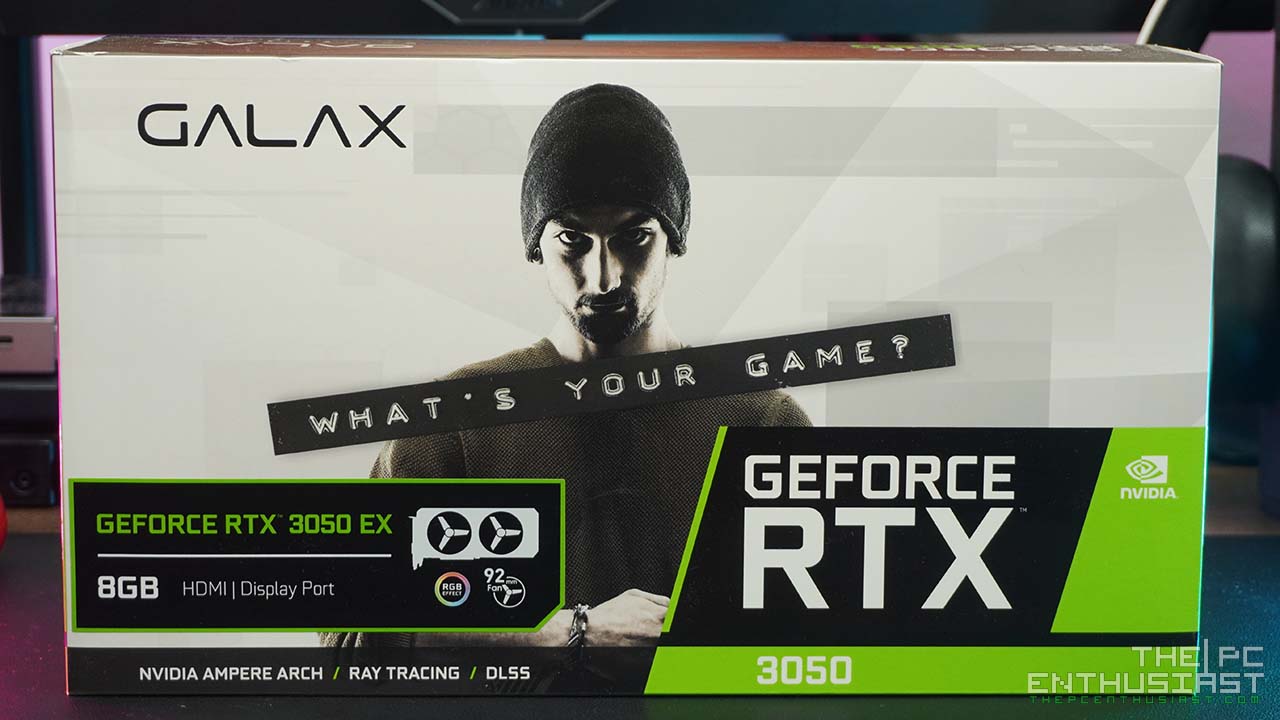
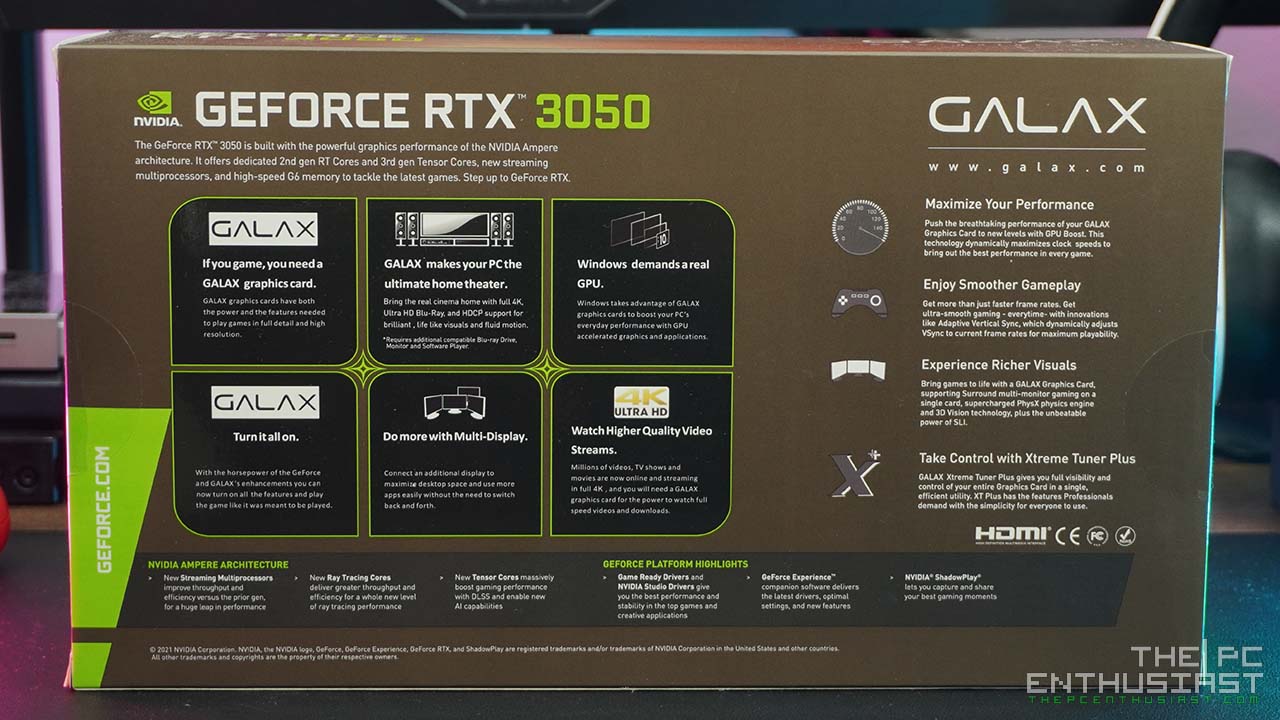
The RTX 3050 EX’s retail packaging is quite small, almost 330mm in length and approximately 184mm in height. Usually, graphics cards retail boxes are big. But lower-end or entry-level cards tend to come in with a smaller box. The last time I got a graphics card with a small box was the ASRock RX 5500 XT. Nevertheless, the graphics card itself is still surrounded by sufficient foam padding inside.
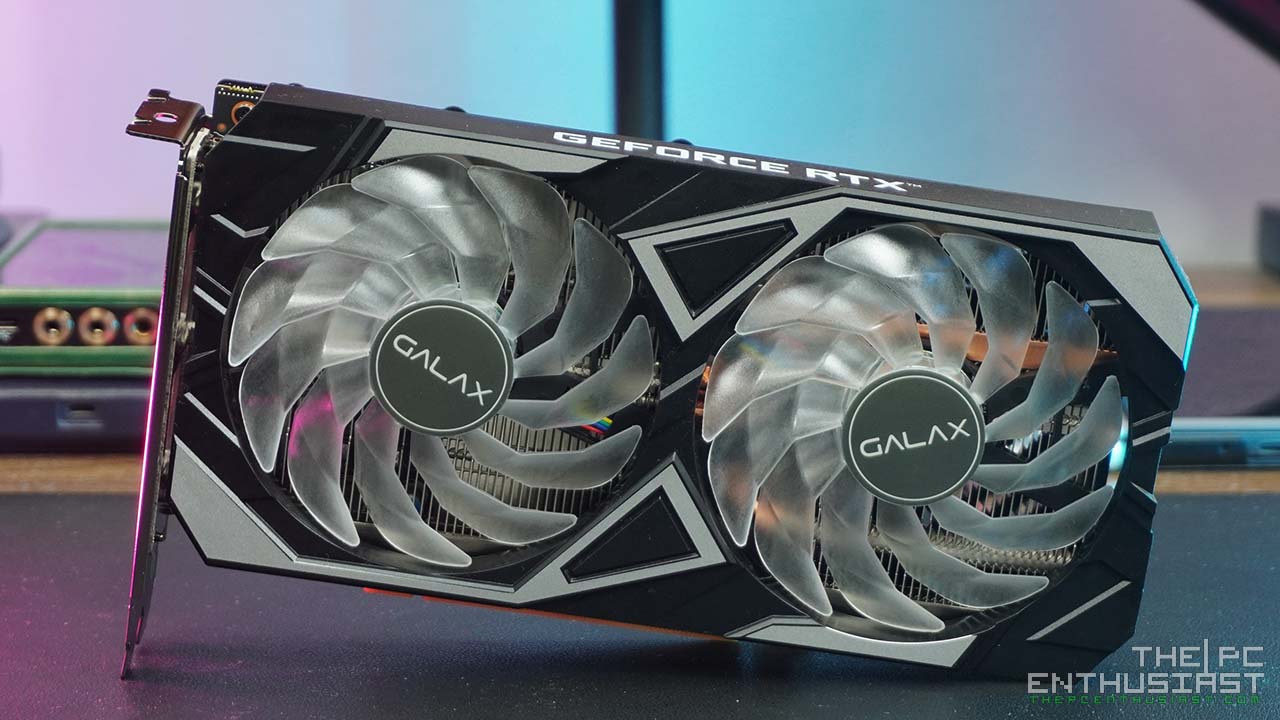
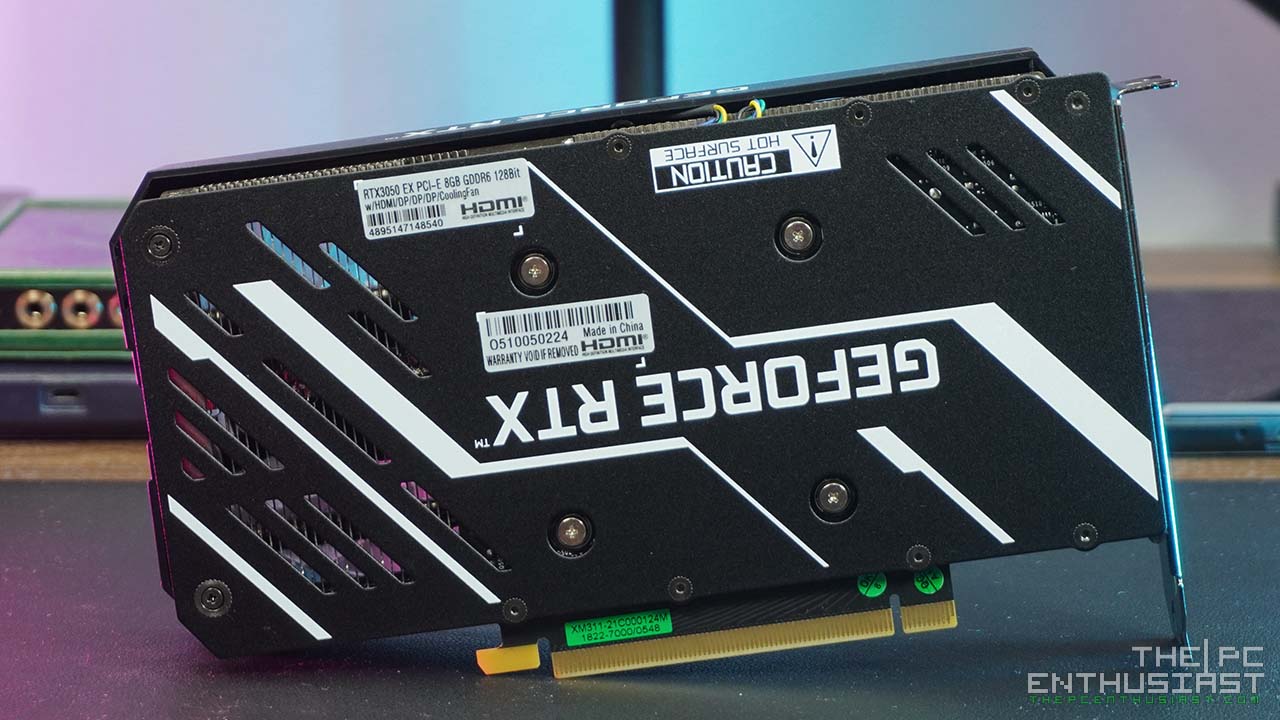
Excluding the PCI bracket, the RTX 3050 EX measures 209mm in length, 118mm in height, and 41.5mm in thickness. The front cooler shroud design is reminiscent of the other EX cards GALAX has. There are some (gray) highlights in the front portion and some white lines at the back. While the front cooler shroud is made of plastic, the backplate is metal.
Despite being an entry-level card, GALAX is using two 92mm “WING” blade fans with RGB lighting on the RTX 3050 EX. However, I don’t think you can sync the RGB lighting on this graphics card. But there is a switch, at the rear end portion, to turn on or off the RGB lighting on the fans.
Looking at the back of the graphics card, you’ll notice that the PCB of the card ends right after the PCIe connector lock. It has a blow-through design at the rear end, which is a common feature on RTX 30 series cards.
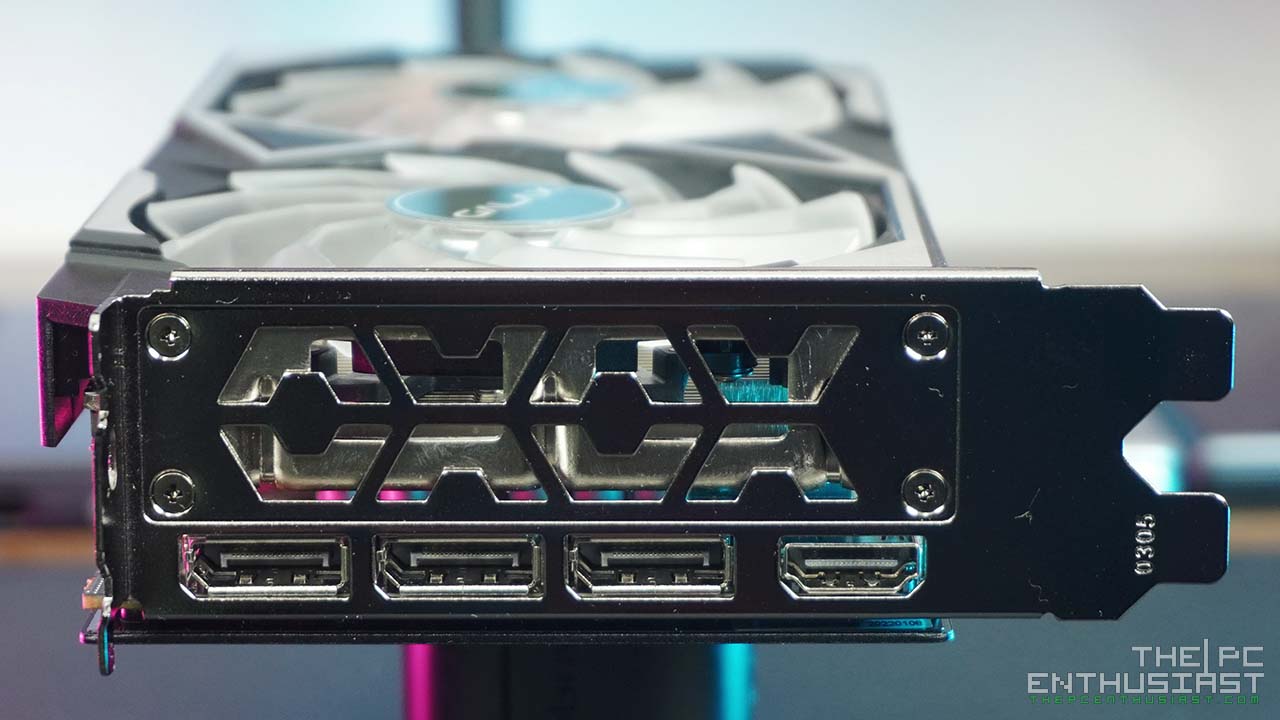
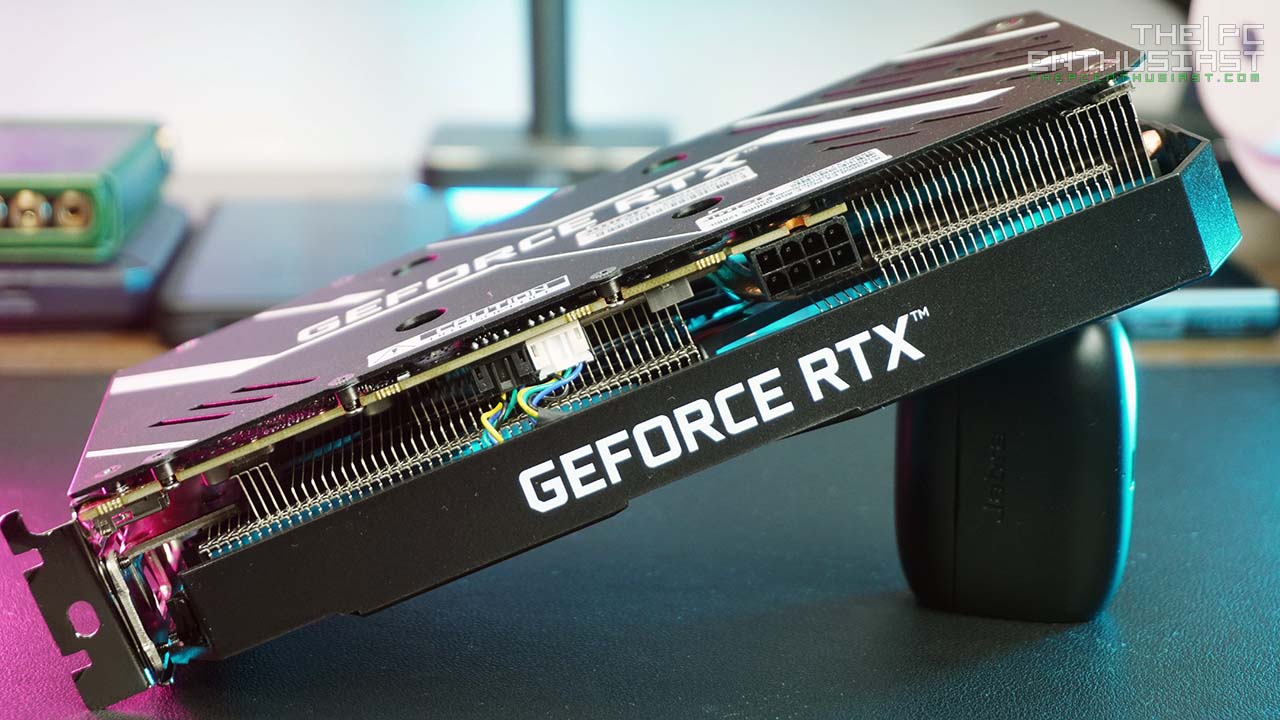
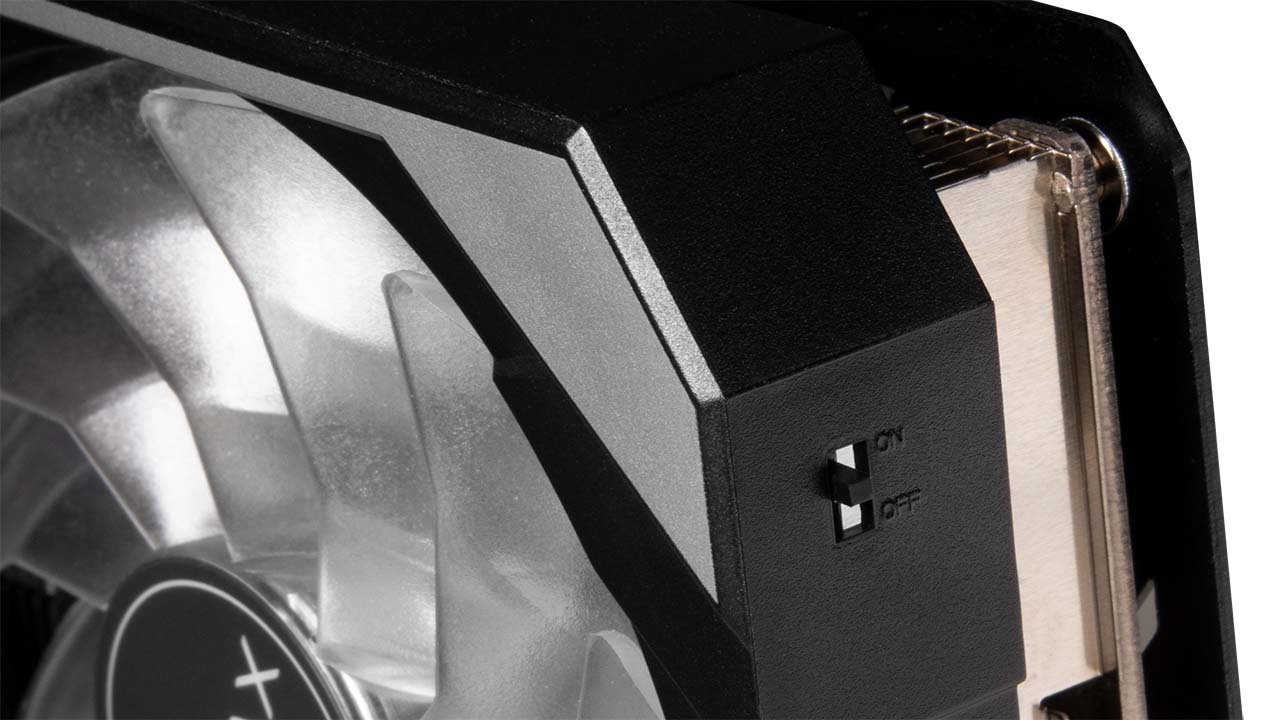
Just like most RTX 30 series cards, the RTX 3050 EX has three DisplayPort 1.4 ports. and one HDMI 2.1 port. It requires a single 8-pin PCIe power connector and at least a 550W PSU to power the card. Even though this is an entry-level card, we still recommend a high-quality 80 Plus certified power supply from a reputable company. Don’t cheap out on the PSU!
I did not open the graphics card, but above you can see how the heatsink looks like beneath the cooler shroud.
The Test Setup
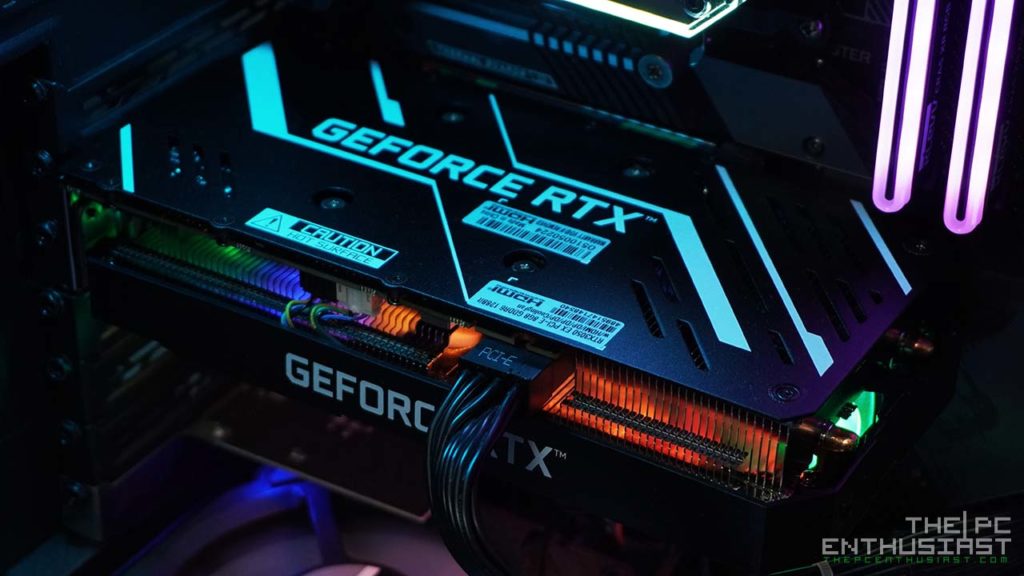
In testing the GeForce RTX 3050, I’m using a Gigabyte X570s Aorus Master powered with an AMD Ryzen 7 5800X. Below are the rest of the specifications of the system:
| Operating System | Windows 10 Pro 64bit |
| Processor | AMD Ryzen 7 5800X |
| Motherboard | Gigabyte X570s Aorus Master |
| Memory | Klevv Cras XR RGB DDR4-3200MHz 16GB (2x8GB) |
| Graphics Card | GALAX GeForce RTX 3050 EX |
| OS Drive | Sabrent Rocket 4 Plus NVMe Gen4 SSD |
| Game Drive | SanDisk Extreme PRO Portable SSD V2 and Extreme Portable SSD V2 |
| Power Supply | SilverStone SX1000 Platinum SFX-L 1000W PSU |
| Chassis | Lian Li O11 Dynamic Mini |
For this test, I used GeForce Game Ready Driver Version 511.32. The graphics card was tested at 1920×1080 FHD and 2560×1440 WQHD resolutions.
For synthetic benchmarks, I used 3DMark’s benchmark suite. I also used the following games to test the graphics card: Assassin’s Creed Valhalla, Cyberpunk 2077, Deus Ex: Mankind Divided, Gears 5, Ghost Recon: Wildlands, Horizon Zero Dawn, Monster Hunter World, Red Dead Redemption 2, Shadow of the Tomb Raider, The Division 2, The Witcher 3 and Watch Dogs Legion.
Below is the GPU-Z screenshot of the GALAX RTX 3050 EX.
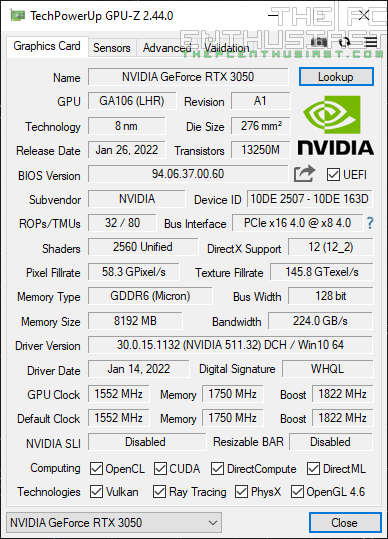
GALAX GeForce RTX 3050 EX Benchmarks
Below are the results that I got with 3D Mark’s benchmark suite. On the left-hand side are graphics scores, while on the right-hand side are the average frames per second (FPS). Some of you might not be interested in synthetic benchmarks, but others would like to see them. It also gives us an idea of the “general performance” of this graphics card.
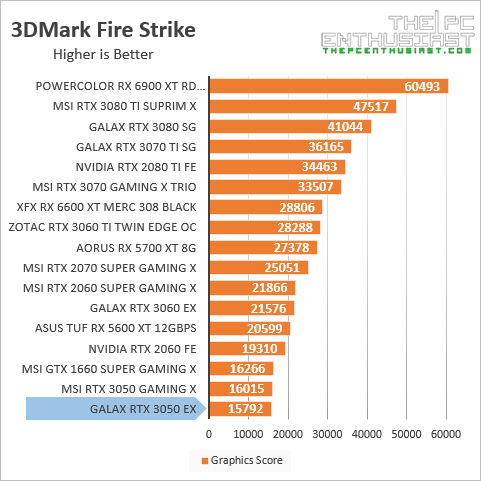

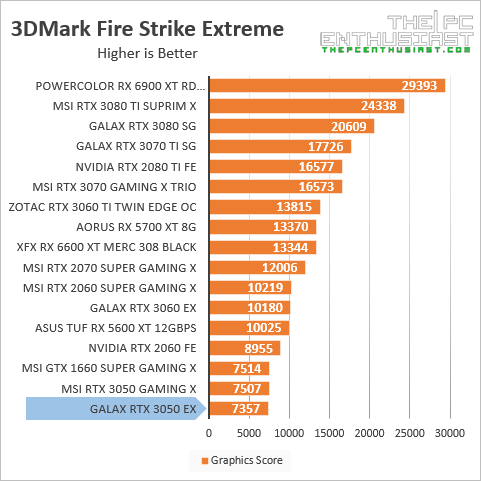
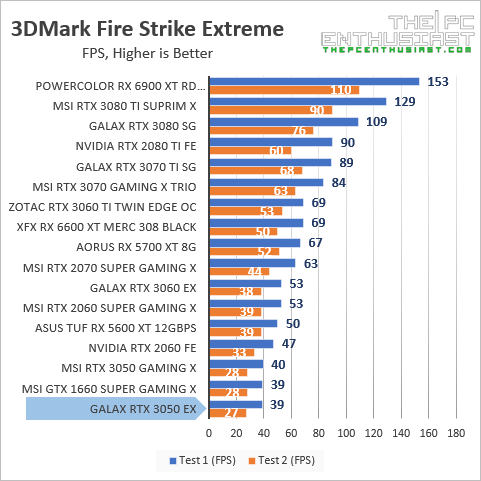
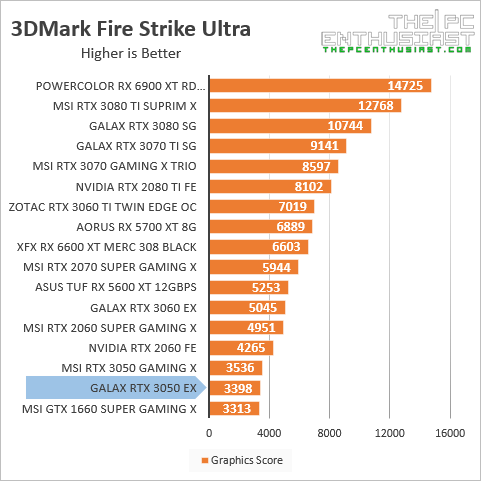
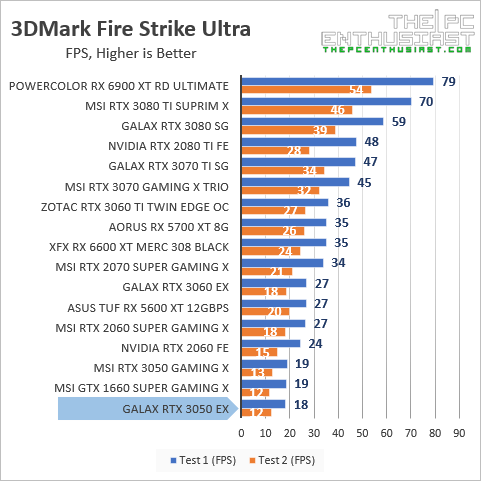
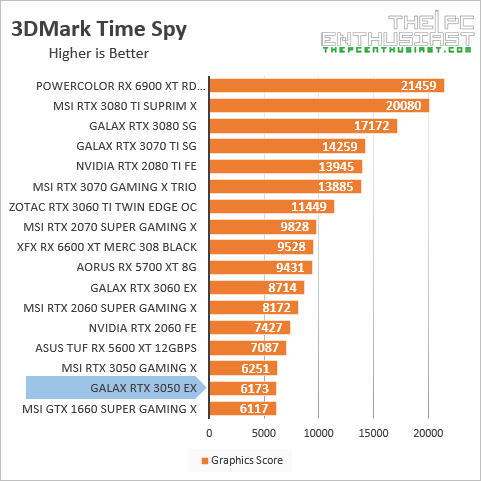
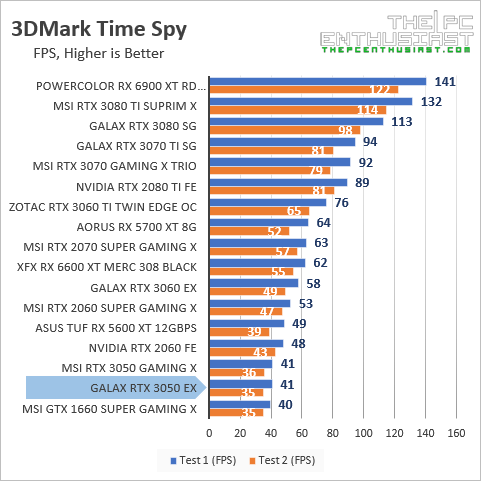
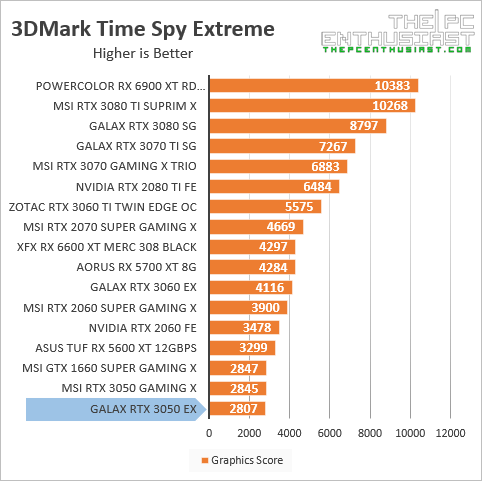
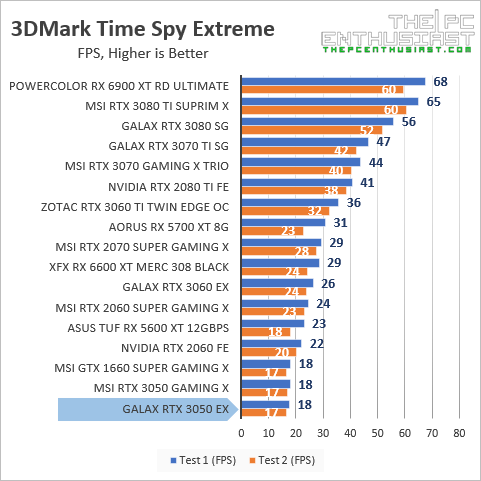
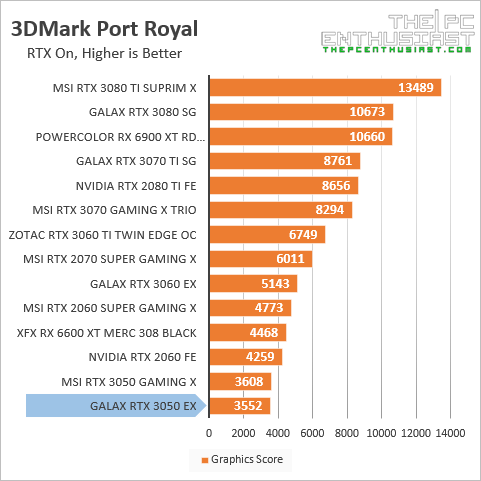
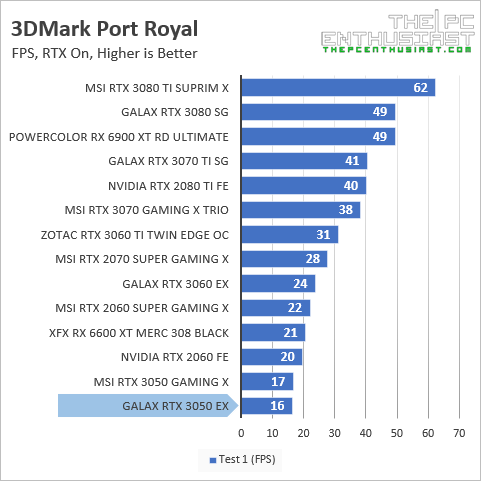
As expected, the RTX 3050 ended at the bottom of the chart. Also, GALAX’s RTX 3050 EX performed on par with MSI’s RTX 3050 Gaming X. Now, remember, the MSI 3050 Gaming X has a slightly higher boost clock speed than GALAX’s RTX 3050 EX. MSI’s 3050 has a boost clock speed of 1845MHz, while GALAX’s only has 1822MHz. Not that it really matters since the GPU will still boost higher and longer if the GPU is cool enough.
When it comes to the cooling solution, I think the MSI RTX 3050 Gaming X has the advantage. However, as you can see from the results above, both the RTX 3050 performed similarly and the performance difference is negligible. Although, point per point or frame per frame, the MSI RTX 3050 is a hairline faster.
1080p Game Benchmark Results
The GeForce RTX 3050 is targeted toward 1080p gaming. Too bad entry-level GPUs nowadays are quite expensive compared to entry-level GPUs back then. But I think this GALAX RTX 3050 EX is cheaper compared to other brands, hopefully. Let’s see how it fares in modern-day AAA game titles in this resolution. Below are the results I got.
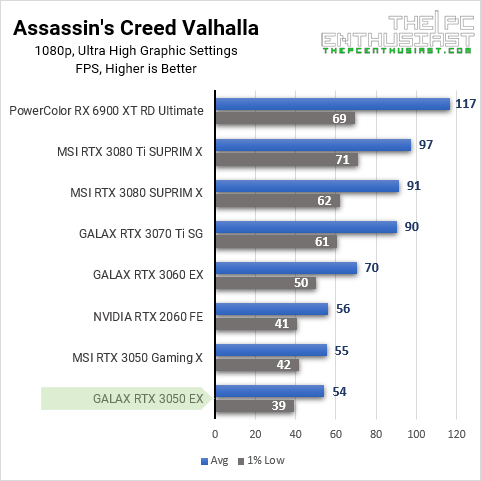
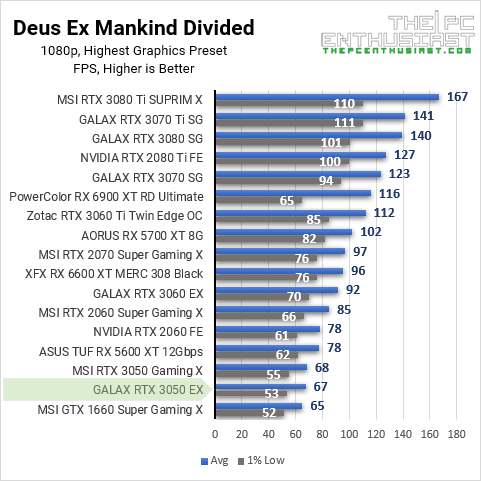
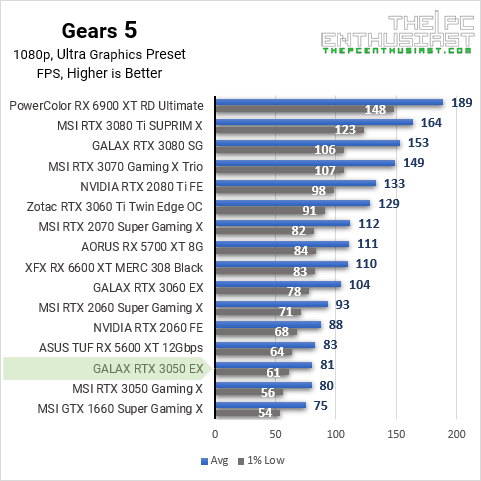
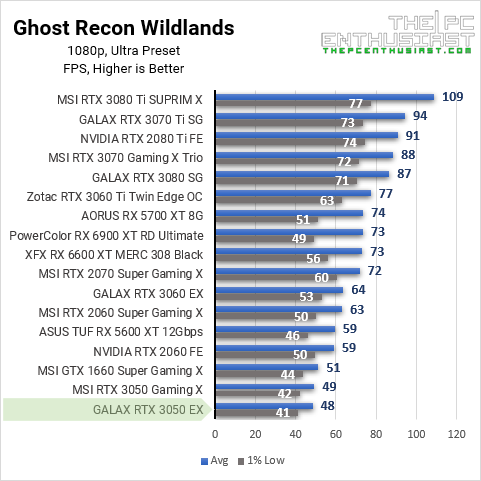
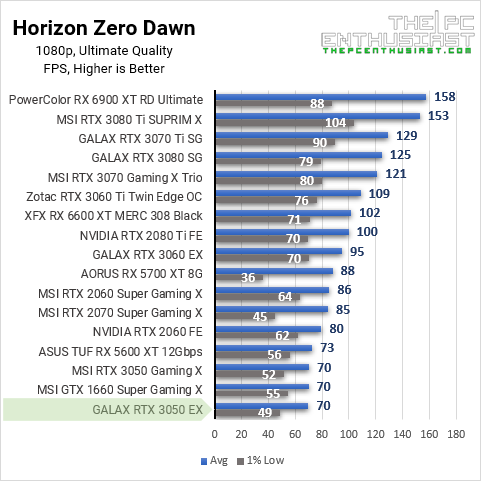
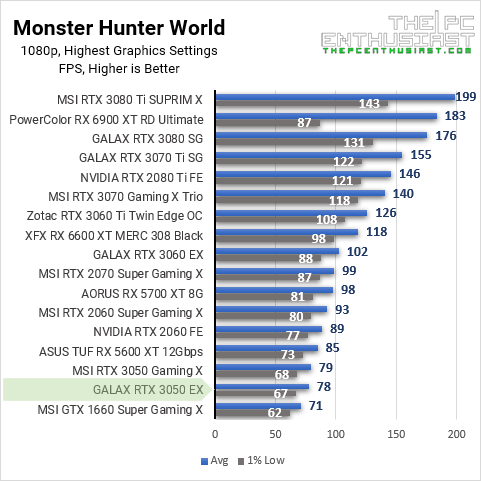
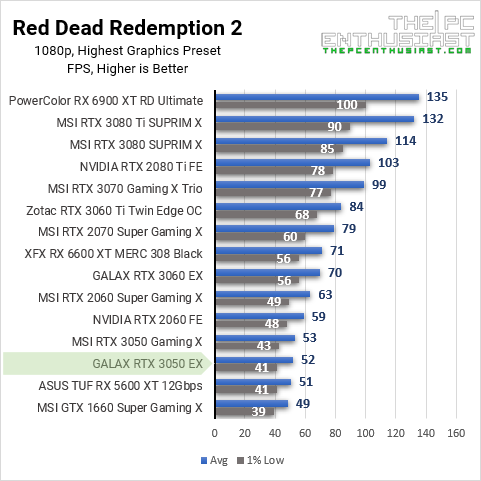
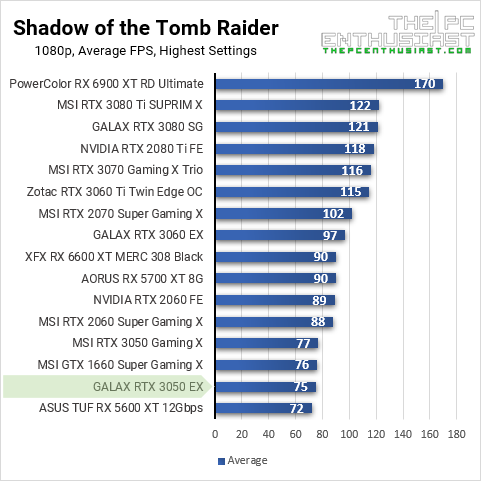
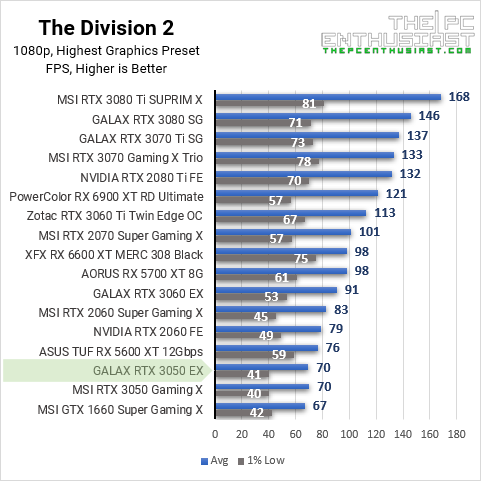
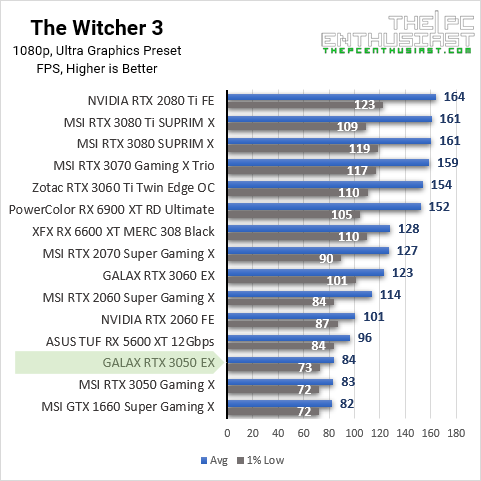
Again, we see both RTX 3050 graphics cards trading blows, with the competition having a negligible advantage in performance. The GALAX RTX 3050 EX was able to drive most of the games above 60 fps in 1080p using the game’s highest graphics settings. You can still get much higher or better frame rates if you tone down the graphics settings. Again, we can see from these results that the RTX 3050 trade blows with the GTX 1660 Super.
The GTX 1660 Super was released back in 2019 and it came with a launch price of $229. Meanwhile, the RTX 3050 has a launch/starting price of $249. It looks like the RTX 3050 is a GTX 1660 Super but with ray tracing and DLSS features.
1440p Game Benchmark Results
The GeForce RTX 3050 isn’t primarily targeted towards 1440p resolution. It’s a 1080p-class GPU. But let’s see how the GALAX RTX 3050 EX fares on a 2560×1440 resolution. Below are the results I got.
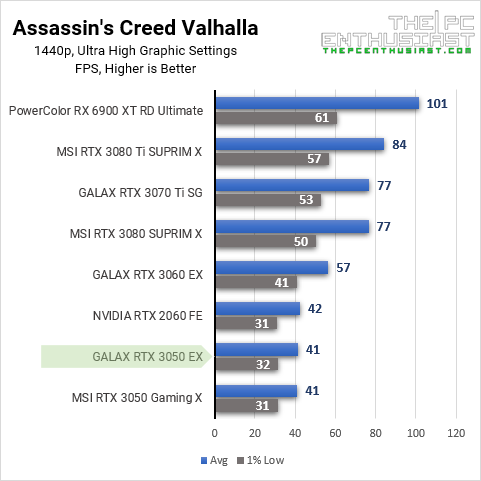
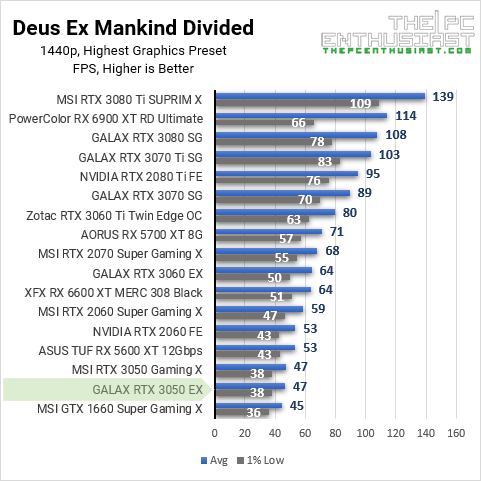
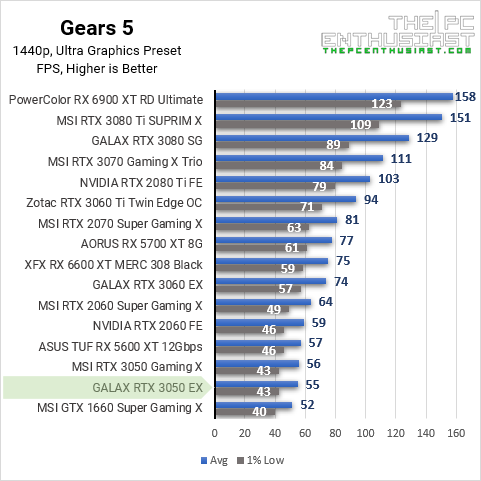
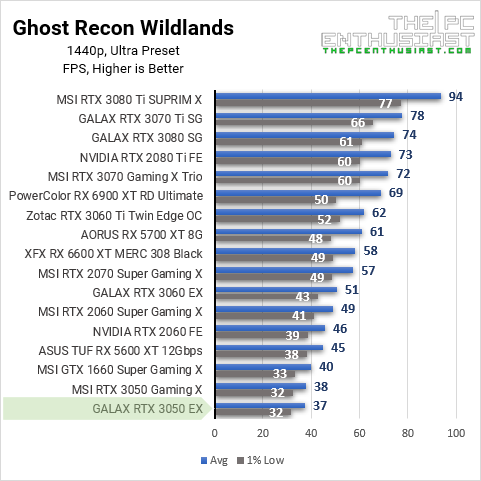
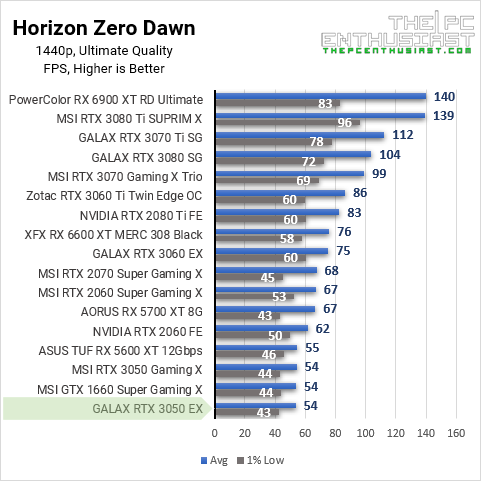
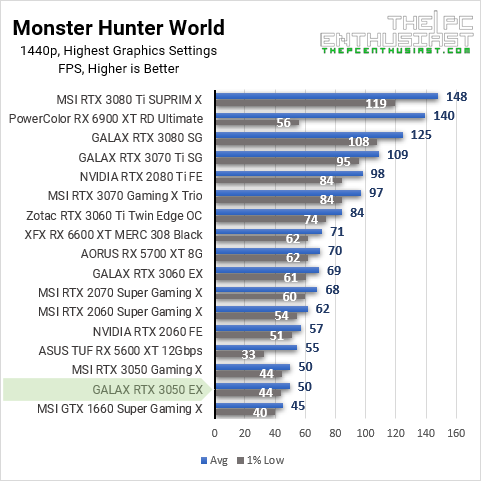
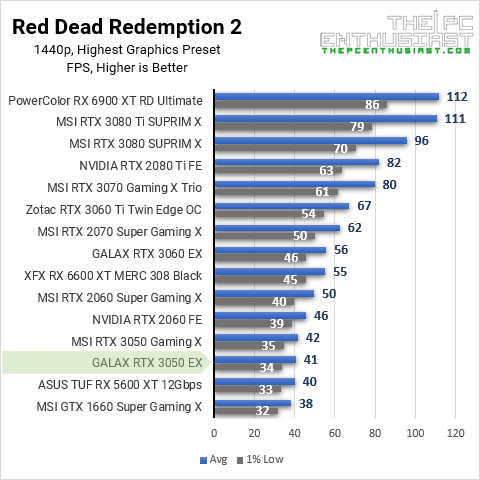
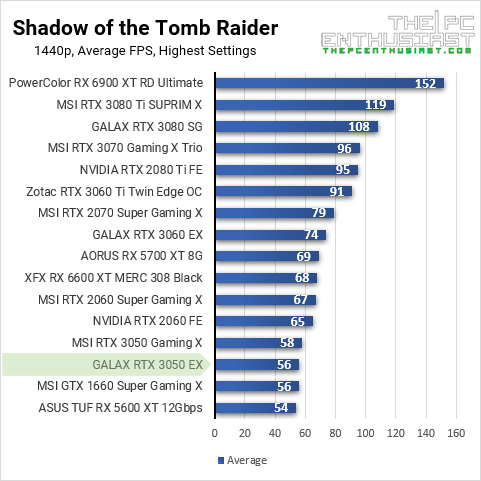
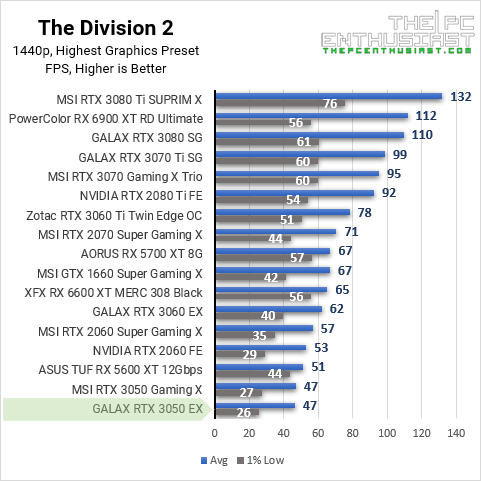
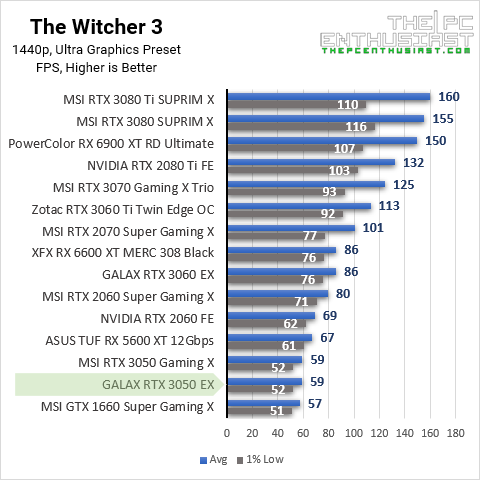
As you can see from the results above, the RTX 3050 is having a hard time keeping the frame rates above 60 fps in 1440p. But remember, I am using ultra graphics or the highest graphics settings. Frame rates would be better or higher if I used high or medium graphics settings.
Nowadays, many games have support for DLSS. If the game has support for DLSS, you can take advantage of this feature and it could help boost the frame rates. I’ll show you below.
RTX 3050 Ray Tracing and DLSS Benchmark Results
As I have said in my first review of the RTX 3050, I’m not expecting that it can handle ray tracing at all. The RTX 2060 was already bad at ray tracing and the RTX 3050 is even slower than the RTX 2060. Also, it performed poorly on the 3DMark Port Royal benchmark.
However, using DLSS could help increase the frame rate. You can take advantage of DLSS only without ray tracing to further boost the frame rates. If you use DLSS with ray tracing, the result may be lower than using traditional rasterization or rendering. Check out the results below.
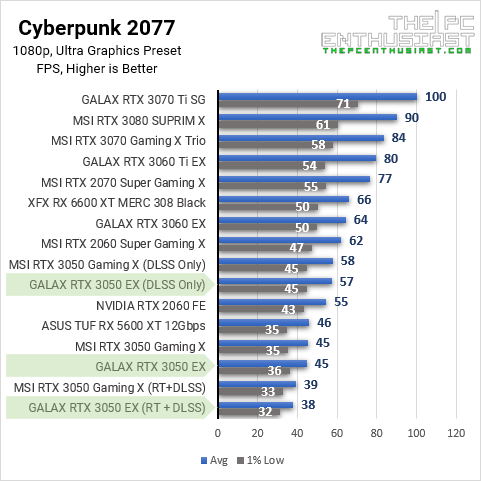
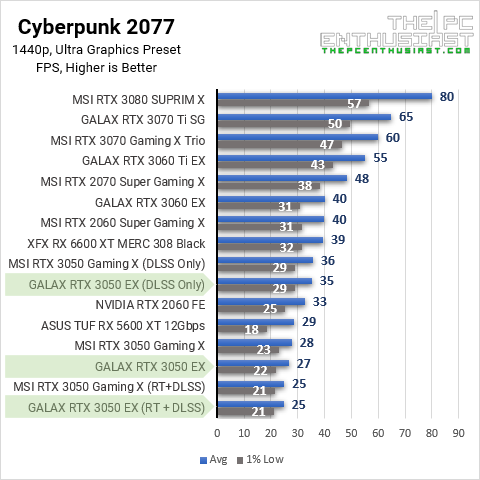
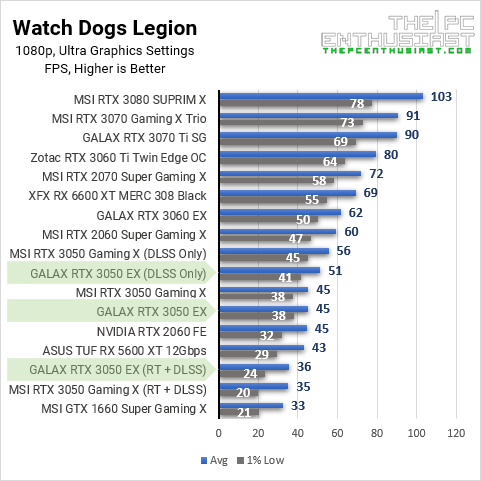
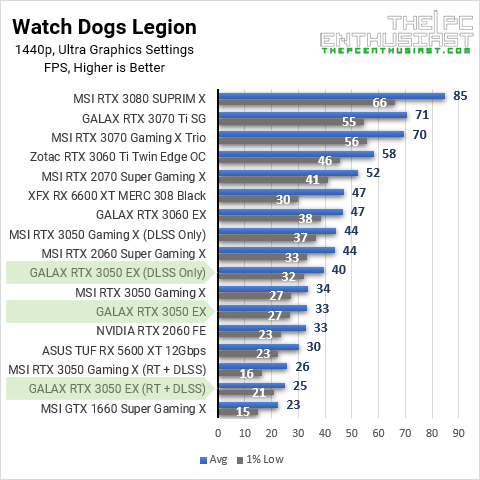
On the charts above, the GALAX RTX 3050 EX-only results are using the traditional rasterized performance. No ray tracing and no DLSS enabled. The other two highlighted results are self-explanatory as I have labeled them. The ray-tracing setting I used is the highest for Watch Dogs Legion, and I used ultra for Cyberpunk 2077. All the DLSS results are using the DLSS quality setting.
I didn’t bother testing the card with RT-only, since it was already struggling even with DLSS enabled to help with the ray tracing. However, with DLSS only, I got higher and better frame rates compared to traditional rasterized settings. Again, I am using DLSS quality in the tests above. If I used DLSS performance, with or without lowering the graphics settings, the frame rates could be a little bit higher.
The results speak for themselves. Time to wrap up this review.
GALAX GeForce RTX 3050 EX Review Conclusion
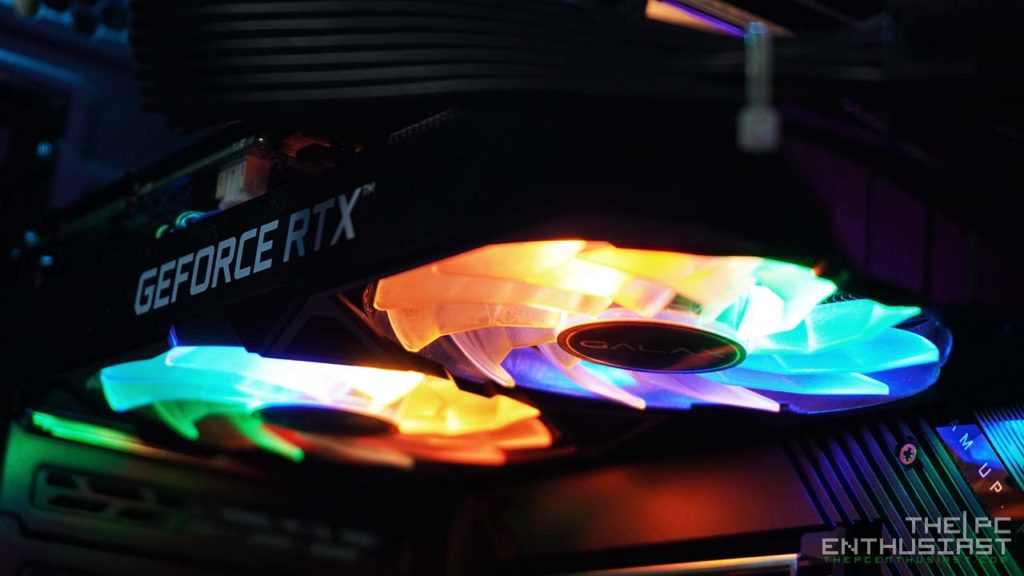
The GALAX RTX 3050 EX is a small and compact graphics card. Its front cooler shroud is made of plastic and there is RGB lighting on the fans. It doesn’t feel as premium compared to the higher-end EX cards but it does perform quite well for a 3050. If you don’t like the RGB lighting, since it can’t be controlled or synced, there is a switch to turn it off. I think the GALAX RTX 3050 EX’s design is simple yet it has the gamer vibe to it. I just hope it is not as expensive compared to other RTX 3050 in the market.
When it comes to performance, the RTX 3050 is like the RTX 2050 we never had, or a GTX 1660 Super but with RTX. It’s a good graphics card for 1080p gaming in general. Maybe not for a high refresh-rate 1080p monitor or 1440p resolution. I’d recommend that you get a much faster graphics card for 1440p.
If you want to experience ray tracing, I would definitely avoid this graphics card. Although the RTX 3050 GPU is capable of ray tracing, it simply lacks the power to drive games with ray tracing enabled, even with the help of DLSS. On the other hand, enabling DLSS only would help get a higher frame rate.
Again, overall, I think the GeForce RTX 3050 is a good graphics card for 1080p gaming. It’s just unfortunate that entry-level GPUs are quite expensive this generation. NVIDIA’s launch price for the RTX 3050 is $249. But I highly doubt that we will see an RTX 3050 at that price, especially since all RTX 3050 graphics cards are made by AIB partners. I just hope that GALAX’s RTX 3050 is cheaper compared to other cards. But even if GALAX set a lower price, there is a possibility that retail stores or sellers would increase the price due to limited availability.
(#ad) Check GeForce RTX 3050 graphics cards’ latest pricing and availability on Amazon.com here.


